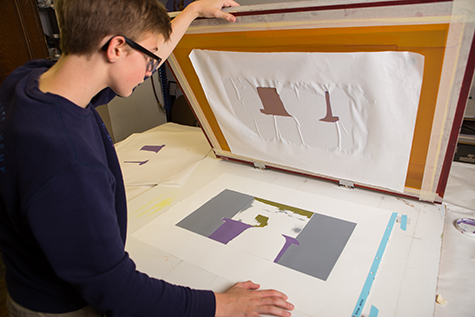The Important Guide to Comprehending Screen Printing and Its Versatile Makes use of
Screen printing has a rich history that goes back to ancient times, advancing into an innovative method utilized across different markets today. This guide explores the details of the screen printing process, detailing its applications in fashion, marketing, and home décor - 10:9 Design reviews. Recognizing these fundamentals can open up creative capacity for both industrial and artistic jobs. The adhering to sections will certainly expose important ideas and methods to enhance one's screen printing undertakings
The History of Screen Printing
Although screen printing has roots that trace back centuries, its advancement shows the creative and technical improvements of numerous societies. Originating in old China, the technique was initially used for decorating fabrics and later infect Japan, where it became indispensable to Ukiyo-e woodblock printing. The technique moved to Europe in the 18th century, where it gained popularity amongst craftsmens and industrial printers. The innovation of image solution in the 20th century transformed screen printing, allowing for more detailed designs and greater performance. Musicians like Andy Warhol additionally pushed its popularity, making use of the medium to develop legendary works that blended commercialism and fine art. By the late 20th century, screen printing had established itself as a versatile method, used in style, advertising, and great art. Today, it continues to advance, integrating electronic innovation and increasing its applications throughout different sectors.
The Screen Printing Refine Explained
Screen printing transforms creative visions right into tangible designs through a series of accurate actions. Initially, an image is created and after that moved onto a screen, usually constructed from fine mesh material stretched over a framework. A light-sensitive emulsion is used to the screen, which is exposed to light, solidifying in areas not covered by the image. After rinsing the unhardened solution, a stencil is developed.
Next, the screen is put over the substratum, whether it be fabric, paper, or another product. Ink is then pressed with the open locations of the pattern utilizing a squeegee, transferring the style onto the substrate listed below. This process can be duplicated for multiple shades, needing separate screens for every hue. The printed item is treated utilizing warmth to assure the ink sticks appropriately, resulting in a sturdy, vibrant style prepared for usage.
Sorts Of Screen Printing Techniques

Furthermore, specialty techniques, such as discharge screen printing, get rid of color from the fabric to develop softer prints, while foil screen printing uses metal aluminum foil to achieve a glossy finish (10:9 Design near me). Each strategy offers distinctive features, catering to numerous innovative needs and production ranges, inevitably broadening the useful site opportunities within the screen printing domain name
Applications of Screen Printing in Different Industries

In check these guys out addition, the signs and marketing fields utilize screen printing for producing appealing screens and banners. This approach allows for bold colors and detailed styles that record attention. In electronic devices, screen printing is used for using conductive inks to motherboard, important for element links. The home style market welcomes screen printing to create distinct styles on fabrics and wall art. Generally, screen printing acts as a critical device across varied areas, boosting items with personalized and aesthetically appealing graphics.
Tips for Effective Screen Printing Projects
While embarking on a screen printing job, careful interest to detail can substantially boost the last result. Picking top quality products is essential; this consists of the screen, inks, and substratums. Making use of appropriate mesh matters can influence ink deposition and information resolution. Preparation is just as crucial; complete cleansing of displays and proper exposure times assure crisp prints.
Next, precise enrollment is critical for multi-color prints. Using placement tools can assist accomplish accurate layering. In addition, testing prints on scrap products before manufacturing assists identify prospective concerns without squandering sources.

Regularly Asked Inquiries
What Materials Are Ideal for Screen Printing on Fabric?
Cotton and polyester blends are ideal for screen printing on textile due to their longevity and ink absorption. In addition, specialized textiles like silk or canvas can produce distinct appearances and surfaces, improving the overall layout high quality.
Just how Do I Tidy and Maintain Screen Printing Tools?
To keep and cleanse screen printing devices, that site one need to consistently wash displays with suitable solvents, inspect mops for wear, lube relocating parts, and shop all products in a completely dry, dust-free atmosphere to extend their life expectancy.
What Are the Environmental Effects of Screen Printing?
Screen printing can have considerable environmental influences, consisting of chemical waste from inks and solvents, water use throughout cleaning procedures, and power usage. Environment-friendly materials and lasting techniques are crucial for decreasing these unfavorable effects.
Can Screen Printing Be Done in the house Efficiently?
Screen printing can be successfully done at home with the right products and methods. Hobbyists can create high quality prints, though success relies on their ability level, tools, and understanding of the procedure entailed.
What Are the Expenses Connected With Beginning a Screen Printing Service?

Starting a screen printing service involves expenses for tools, materials, and office. First costs commonly range from a couple of hundred to several thousand bucks, depending upon the range, top quality of machinery, and preferred manufacturing capability.
Screen printing has an abundant background that dates back to ancient times, developing into a sophisticated technique used throughout various sectors today. Another technique, rotary screen printing, utilizes cylindrical screens, facilitating constant printing on textile rolls, thereby boosting effectiveness for massive productions. Additionally, specialty strategies, such as discharge screen printing, get rid of color from the fabric to create softer prints, while foil screen printing uses metal aluminum foil to achieve a shiny coating. In the style sector, screen printing is widely utilized to produce vivid designs on apparel, allowing brands to showcase their distinct designs. Cotton and polyester blends are suitable for screen printing on textile due to their resilience and ink absorption.